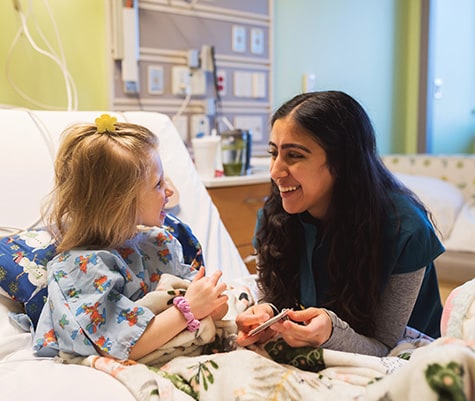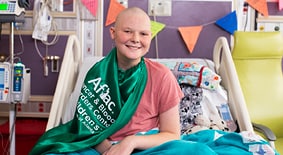Sarcoma refers to a group of cancers that occur in the bones and soft tissues in various parts of the body. These cancers can manifest in the body in two ways: in the bone, which results in bone tumors, or in the body’s soft tissue. Some of the types of sarcoma treated at the Aflac Cancer and Blood Disorders Center include:
- Bone tumors: Ewing sarcoma, osteosarcoma and chondrosarcoma
- Soft tissue sarcomas: rhabdomyosarcoma and other soft tissue sarcomas, including rare sarcomas
The Aflac Cancer and Blood Disorders Center of Children’s Healthcare of Atlanta offers a full range of treatment options for bone tumors and soft tissue sarcomas. We will create a treatment plan just for your child, as treatment approaches can vary. A child with a bone tumor or soft tissue sarcoma may undergo any one of these treatments or a combination of them. Our team works closely with each family to determine the best course of action. If surgery is necessary, your medical team will carefully explain and help you plan the best course of treatment for your child. Treatment options include:
In some cases, amputation may be the only treatment option. Amputation is a surgical procedure performed to remove a diseased portion of your child’s extremity. During this procedure, the cancerous tumor and the rest of the limb below the cancer is removed. Sensitivity, swelling and pain can be common during the healing process.
As prosthetic technology has advanced, so has the function and ability of patients who require an amputation. There are also a wide range of adaptive sports and activities available to these patients. To help families, we connect them to patients and families who have been through the same procedures and recoveries. The loss of a limb can be scary, but our pediatric-trained specialists can help children who face this option realize an amputation will only briefly slow them down.
Our Developmental Therapeutics Program offers some of the most promising new cancer treatments through early-phase clinical trials for children who have relapsed or who have difficult-to-treat cancers.
In radiation therapy, high-energy rays are used to kill or damage cancer cells.
In a resection, all or part of the tumor is surgically removed.
Limb-sparing surgery is a procedure to keep a child’s extremities after being diagnosed with osteosarcoma. During the procedure, only the malignant tumor tissue is removed. The resected portion of tissue and bone is replaced by metallic (prosthesis) or bone transplants (allograft). If your child is under 10 years old, he may be a candidate for a growing prosthesis. The type and location of the cancer may also impact whether limb-sparing surgery is the best surgical option for your child.
The first step to identify whether your child is a good candidate for limb-sparing surgery is a biopsy, in which a piece of tissue is removed to diagnose his condition. The next step is staging, where the extent and/or spread of the tumor is identified. Sophisticated radiographic technology is used in staging. Your child’s surgeon will then decide if the tumor can safely be removed in its entirety without compromising the overall integrity of the limb. Tumors that are too close to a major nerve or artery may not be ideal for limb-sparing surgery. If not, an amputation or rotationplasty may be recommended.
Sometimes the cancer affects more tissue and bone than can be replaced by a bone graft. This is when limb sparing surgery with an endoprosthesis, or removal of the cancer in the bone without amputation, can be a good option. During the procedure, the cancerous part of the bone in the child’s arm or leg is removed and replaced with a metal and plastic prosthesis, a cadaver bone, or a combination of both. This is called an endoprosthesis, which allows the limb to look similar to how it did before the procedure.
There can be several challenges associated with limb sparing surgery using an endoprosthesis. If the child is still growing, there will be differences in limb length because the replaced section of bone doesn’t grow. Also, while the child can have normal function with the limb, it will be weaker and more fragile. This means the child will be limited in participating in certain activities like high-impact sports.
If the affected bone is in the leg, the child will have to use crutches while the bone is healing after surgery. The child will also experience some weakness following the surgery due to muscle involvement. Physical therapy can help build back strength in the affected limbs.
This procedure is for patients whose cancer is limited to a small section of bone, and surrounding tissues are disease-free.
In a bone graft procedure, the cancerous part of the bone is removed and then replaced with a graft. The graft can be taken from another healthier bone (autograft) or from a cadaver (allograft). The graft will eventually become a living and growing part of the patient that is free of cancer.
It allows the joints and bones to stay intact and often maintains close to full function in the affected limbs after recovery. That function may vary depending on the amount of bone removed.
If the affected bone is in the leg, the child will have to use crutches while the bone is healing. There will also be some weakness following the surgery due to muscle involvement. Physical therapy can help build back strength in the affected limbs.
Rotationplasty is a form of limb sparing surgery for the femur (thighbone), knee or tibia (shinbone). In this procedure, the cancerous part of the bone is removed, usually including the knee. The remaining ankle is then rotated 180 degrees and reconnected to the rest of the leg to create a new knee joint. This procedure, while seeming drastic, results in more function and durability when combined with a below-the-knee prosthesis.
In a rotationplasty procedure for cancer, the cancerous part of the leg is removed. This usually includes the knee. The healthy, lower part of the leg is then rotated 180 degrees so the foot is turned around. It is then attached to the remaining part of the upper part of the leg. This allows the healthy ankle joint to work as a knee joint. The new knee joint offers enough function to power below-the-knee prosthesis. A rotationplasty procedure often has fewer complications and results in a more durable joint. This means there are typically fewer secondary procedures. As your child grows, his new knee joint will become level with his other knee, eliminating any limb length differences.
The biggest benefit of a rotationplasty is improved function and durability. The new knee joint allows children to have a more natural gait and stride with a below-the-knee prosthesis. It also makes it likely he will be able to participate in the same activities and sports as before the cancer. This new knee joint also provides feeling and sensation, allowing your child to know where his knee is during walking and running.
Stories of Hope and Inspiration From Our Patients
The Aflac Cancer and Blood Disorders Center is committed to advancing pediatric cancer research and medicine by developing new techniques, treatment and cures for children and young adults with bone and soft tissue sarcoma. As Georgia’s top pediatric cancer research center, we are home to one of the largest clinical trial programs in the country, through which we offer our patients access to novel childhood cancer and blood disorders treatment options.
View our open research studies:
- Brain Tumors
- Bone Marrow Transplant
- Developmental Therapeutics
- Leukemia and Lymphoma
- Solid Tumors
- Survivorship
Receiving a cancer diagnosis for your child can be an emotional and overwhelming experience. At the Aflac Cancer and Blood Disorders Center, we are here to support you and your family. Whether explaining treatment options to a teen or helping a child through chemotherapy treatments, we make it our mission to provide the best care—and best experience—for every child. As a parent or guardian, you play an important role in your child’s well-being. Not only are you a vital member of your child’s healthcare team; you are a source of security and comfort.

We work to support your whole family while your child is in our care—and after she goes home.
Contact Us 404-785-1200




